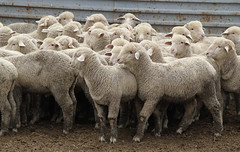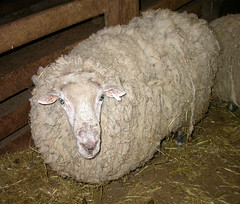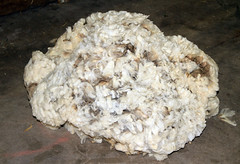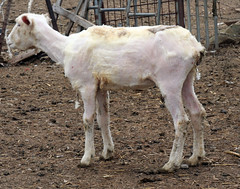- Sheep 201 Index
- Other web sites

Comb

Cutter

Slick shear comb

Electric shears

Hand/blade shears
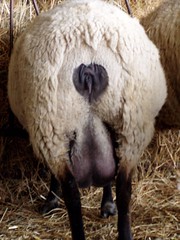
Crutched ewe
Image by Kelly Cole
ShearingContinuous growth
Most breeds of sheep grow wool continuously, so it is important to shear them at least once per year. In 2013, the average sheep in the U.S. produced 7.3 lbs. of grease wool. Fleece weights vary by breed, genetics, and shearing interval. Shearing is usually done in the spring, so sheep don't get overheated in the summer.
Prior to lambing
Preferably, sheep are sheared prior to lambing. There are many advantages to shearing sheep prior to lambing. Sheared sheep take up less room in the barn and around feeders. It is easier for lambs to nurse sheared ewes. The fleeces will be clearners.However, sheep that are shorn in the winter require good nutrition and shelter, as a freshly shorn sheep has a higher critical temperature than a sheep with a fleece. Some producers shear their sheep twice per year.
Shearing
Anyone can attempt to shear a sheep, but not everyone will do a good job. Shearing is a specialized skill. It is hard work. Shearing requires skill so that sheep are shorn efficiently without cuts or injuries to the sheep and shearer. If shearing is not carried out skillfully, it is stressful to the sheep. It is best to hire a professional shearer to shear sheep.Small sheep farms often have a difficult time finding someone to shear their sheep. Small farms can save money by bringing sheep to a central location for shearing. Producers can learn to shear by attending shearing schools. Many states hold annual sheep shearing schools.
Large flocks of sheep are usually sheared by shearing crews who bring a trailer that accomodates shearing, as well as fleece handling and packing.
Before electric shears (up until about the 1880's), sheep were sheared with hand shears or blades. In some parts of the world where electricity is limited or not available, sheep are still blade sheared. Compared to machine-shorn sheep, blade shorn sheep will have more wool.
The New Zealand method is the most common method of electric shearing. Many shearers of Spanish or Mexican descent use a style of shearing that requires the legs of the sheep to be tied.
Electric shears
Electric shears have three basic parts: the handpiece, the comb and the cutters. Commercial sheep shears, having a powerful electric motor attached to the ceiling. Portable electric shears have the motor inside the handle of the handpiece.
Expect to pay $250-500 for a good set of electric shears. More teeth on a comb generally mean a cut closer to the skin. Cutters generally have 4 points, triangular protrusions, and attach to the handpiece by way of four "fingers" that press them firmly against the comb.
Cutters are the first thing to dull, and you will probably want about 3 cutters for every comb. Changing cutters is quick, and it ensures a sharp tool. Remember, dull tools are dangerous tools. Cutters cost $10-15. When purchasing shearing combs, it is important to buy a type of comb that is best suited to the sheep you will be shearing.
Preparing sheep for shearing
A sheep shearer should be contacted well in advance of shearing time. Sheep should be penned before shearing. They should be sorted into the following groups: lambs, yearlings, rams and ewes by breed and/or grade. Sheep should be fasted before shearing. This will result in a much cleaner shearing floor.
A full stomach also contributes to animal discomfort during shearing. Wet sheep should not be shorn. Sheep should be sheared on a clean, dry surface (e.g. wood, carpet, canvas, or concrete). The shearing area should be swept after each sheep to provide a clean surface for the next.
Skirting Fleeces
After shearing, belly wool and tags should be separated from the rest of the fleece. Every sheep producer should learn how to skirt and roll a fleece. To skirt, throw the fleece flesh side down, so the dirty end of the fleece faces up. Remove off-color wool, tags around the breach, very short and matted wool, and other contaminated areas.
Then roll the two sides of the fleece in toward the middle and roll the fleece from one end to the other. The flesh side will face out, created a clean, attractive package for the buyer. It is usually not necessary to tie fleeces. Some wool pools will discount fleeces that are tied. If fleeces are tied (for competition), only paper twine should be used.Skirting is especially important for high value wool, wool that will be sold to hand spinners, or for fleeces that will be exhibited.
Packaging wool
Small producers can package their fleeces in cardboard boxes or plastic garbage bags. Wool should not be packaged in poly feed sacks or burlap bags. This will contaminate the wool. Large producers should pack their wool in large square bales. The preferred packaging material is clear plastic wool bags.Different grades or classes of wool should be packaged separately. All belly wool, tags, off-color, burry, seedy, chaffy, cotted, stained or dead wool should be handled and bagged separately. Black wool should be kept separate from white wool. Bags of wool should be labeled. Properly sorted and labeled wool will bring more money to the grower. Wool should be stored in a clean, dry place until ready for market.
Improving Wool Quality
There many steps producers can take to improve the quality of their wool clip. Since black and colored fibers can seriously undermine the value of a white wool clip, black, colored, or spotted sheep should be sheared last and black wool should be kept separate from white wool. One of the major wool contaminants is polypropylene: hay baling twine, poly tarps, and poly feed sacks. Polypropylene should never be allowed to come into contact with wool.Paint branding can be damaging to wool. If paint brands are used, only approved scourable solutions should be used. Sheep should not be paint branded prior to shearing time. Medium size paint irons should be used and the paint should be applied lightly.
Vegetable matter (e.g. seeds, straw, chaff, and burrs) is a primary source of wool contamination. To help prevent this type of contamination, sheep should not be bedded on hay or straw before shearing.Overhead hay feeders should be avoided. Hays which allow sheep to poke their heads through will also result in wool contamination. Poor nutrition can weaken the strength of the wool fiber and result in breaks in the wool fiber.
Hair sheep
The widspread popularity of hair sheep breeds poses a significant threat to wool quality. Hair is damaging to a wool fleece. The fleeces from hair x wool crosses should be discarded. Hair x wool crosses should be sheared last.If hair sheep and wool sheep are raised together, hair may get into the fleeces of the wool sheep. Wool sheep and hair sheep should not be housed or pastured together when the hair sheep are actively shedding. Ideally, they should never be kept together.
Crotching/Crutching
Crutching is a short, quick modification of shearing. Only the wool in the vulva area and around the udder is removed. If ewes are ot sheared before lambing, it is a good idea to crotch them. Crutching offers some of the same advantages as shearing prior to lambing. Crutching is the removal of wool from the crutch of a sheep to keep the area dry and less attractive to blowfly strike.Not All Sheep Require Shearing
It is generally not necessary to shearing hair sheep and some hair x wool crosses. In addition, many of the primitive sheep breeds will also naturally shed their coats.
The Shear Facts
Professional sheep shearers can shear sheep in under a minute. World records are one sheep sheared in 38 seconds; one lamb sheared in 19.8 seconds; 720 sheep sheared in 9 hours; and 839 lambs sheared in 9 hours. The record for blade shearing was set in 1892 and still stands: 321 sheep in 7 hours and 40 minutes.In 1994, Australian scientists invented a way of removing the wool from sheep without shearing. They inject the sheep with a special hormone, then wrap them in tight hairnets. Three weeks later, the fleece can be peeled off. The new wool harvest technology is called Bioclip™. Australian scientists also developed a robot for shearing sheep.
Researchers are currently trying to breed sheep with bare britch and crutch areas to make shearing easier and to help prevent fly strike.
<= SHEEP 201 INDEX
Copyright© 2021. Sheep 101 and 201.

